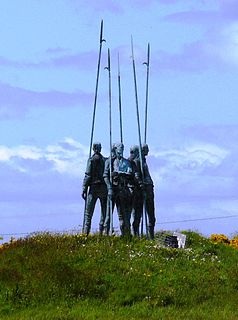
New Ross is a town in southwest County Wexford, Ireland. It is located on the River Barrow, near the border with County Kilkenny, and is around 20 km north east of Waterford. In 2016 it had a population of 8,040 people, making it the fourth-largest town in the county.

The Irish Confederate Wars, also called the Eleven Years' War, took place in Ireland between 1641 and 1653. It was the Irish theatre of the Wars of the Three Kingdoms – a series of civil wars in the kingdoms of Ireland, England and Scotland. The war in Ireland began with a rebellion in 1641 by Irish Catholics, who tried to seize control of the English administration in Ireland to force concessions for Catholics. This developed into an ethnic conflict between Gaelic Irish and old English Catholics on one side, and English and Scottish Protestant colonists on the other. Catholic leaders formed the Irish Catholic Confederation in 1642, which controlled most of Ireland and was loosely aligned with the Royalists. The Confederates and Royalists fought against the English Parliamentarians and Scottish Covenanters. In 1649, a Parliamentarian army led by Oliver Cromwell invaded Ireland and by 1653 had conquered the island.

The Irish Rebellion of 1798 was an uprising against British rule in Ireland from May to September 1798. The United Irishmen, a republican revolutionary group influenced by the ideas of the American and French revolutions, were the main organising force behind the rebellion. It was led by Presbyterians angry at being shut out of power by the Anglican establishment, joined by Catholics, who made up the majority of the population. Many Irish Ulster Protestants sided with the British, resulting in the conflict taking on the appearance of a sectarian civil war in many areas, with atrocities on both sides. A French army which landed in County Mayo in support of the rebels was overwhelmed by British and loyalist forces. The uprising was suppressed by British Crown forces with a death toll of between 10,000 and 30,000.

The 5th Royal Irish Lancers was a cavalry regiment of the British Army. It saw service for three centuries, including the First World War and the Second World War. It amalgamated with the 16th The Queen's Lancers to become the 16th/5th Lancers in 1922.

The Scullabogue massacre was an atrocity committed in Scullabogue, near Newbawn, County Wexford, Ireland on 5 June 1798, during the 1798 rebellion when some insurgents massacred up to 200 noncombatant men, women and children, most of whom were Protestant, held prisoner in a barn which was then set alight. A participant in the rebellion, General Thomas Cloney, put the death count at 100.

The Battle of Vinegar Hill, was an engagement during the Irish Rebellion of 1798 on 21 June 1798 when over 13,000 British soldiers launched an attack on Vinegar Hill outside Enniscorthy, County Wexford, the largest camp and headquarters of the Wexford United Irish rebels. It marked a turning point in the rebellion, as it was the last attempt by the rebels to hold and defend ground against the British military. The battle was actually fought in two locations: on Vinegar Hill itself and in the streets of nearby Enniscorthy.
John Kelly lived in the town of Killanne in the parish of Rathnure and was a United Irish leader who fought in the Irish Rebellion of 1798.

General Jean Joseph Amable Humbert was a French soldier, a participant in the French Revolution, who led a failed invasion of Ireland to assist Irish patriots in 1798. Born in the townland of La Coâre Saint-Nabord, outside Remiremont Vosges, he was a sergeant in the National Guard of Lyon. He rapidly advanced through the ranks to become brigadier general on 9 April 1794 and fought in the Western campaigns before being allocated to the Army of the Rhine.
The Battle of Tubberneering was a battle of the Wexford Rebellion fought on 4 June 1798 between Crown forces and United Irish insurgents, at Tubberneering south of Gorey in the north of County Wexford. The rebels ambushed and routed the British.

John Murphy was an Irish Roman Catholic priest and one of the leaders of the Irish Rebellion of 1798 in Wexford who was executed by British soldiers.
Events from the year 1798 in Ireland.
Events from the year 1643 in England.
Events from the year 1643 in Ireland.
Lacken is a rural agricultural area about two miles outside the town of New Ross in Co. Wexford, Ireland. Central to the area is Lacken Hill, a hill planted with a mix of coniferous and deciduous trees which has a public walk-way up through the wood. It is a popular area for walkers and cyclists as there are numerous paths and tracks in the wood.

The Wexford Rebellion refers to the outbreak in County Wexford, Ireland in May 1798 of the Society of United Irishmen's Rising against the British domination of Ireland. It was the most successful and most destructive of all the uprisings that occurred throughout Ireland during the 1798 Rising, lasting from 27 May 1798 until about 21 June 1798. The Wexford Rebellion saw much success despite County Wexford not being thought of as an immediate threat by the government, because of the spontaneous risings that occurred both before and after the significant rebel victories in Oulart, Enniscorthy, and Wexford town.

B Battery, Royal Horse Artillery is a Close Support Battery of 1st Regiment Royal Horse Artillery. It is currently based in Assaye Barracks in Tidworth Camp.
The Battle of Newtownmountkennedy was a battle fought on 30 May 1798, between forces of the British Crown and a force of Native Irish Rebels, during the Irish Rebellion of 1798. Approximately 170 Irish rebel forces were killed out of 1000, followed by an execution of the Rebels’ leader, Michael Neil.









